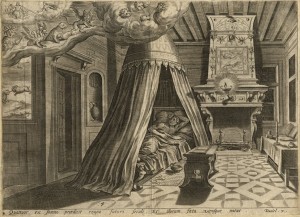Last weekend, I saw this article on sleep habits on the BBC news website:
The myth of the eight-hour sleep
If you scroll down, you will see two prints used by Prof Ekirch as visual evidence of his findings on sleeping patterns before the 17th century. This sounds like a very Doucean subject -and the search for images of how people used to spend their nights in the past is also a way in which Douce’s collection of prints could have been used (see Ellis’s enquiry about bathing habits in a previous post).
The obvious places to look for this kind of image would be either sets of the Four Times of Day or the folder labelled ‘Ancient Bedsteads and Bedchambers’, where I found this engraving by Gerard de Jode after Hans Vredeman de Vries:
This print was part of a series entitled Thesaurus Sacrarum Historiarum veteris testamenti. Douce probably regarded it as a source of information on what a 16th-century Netherlandish bedroom looked like. I have not chosen it to suggest that having apocalyptic visions was one of many activities that took place during the ‘waking period’ between the first and second sleep. But the article also refers to how some people ‘used the time to meditate on their dreams’, which is what Daniel might be doing here.

